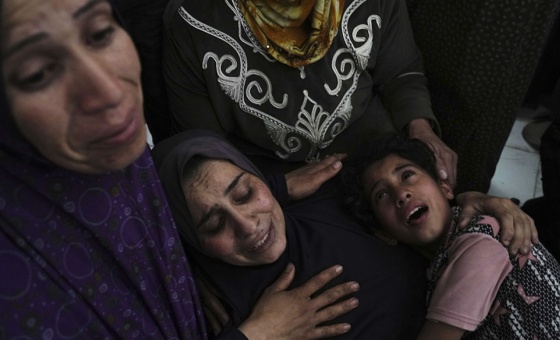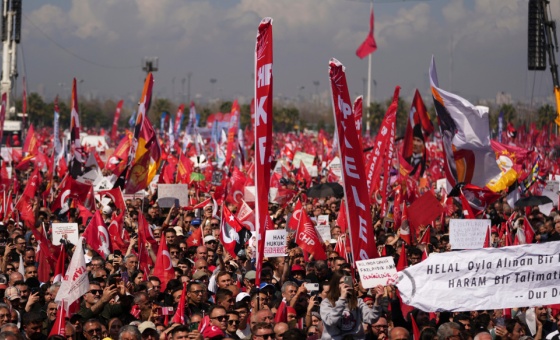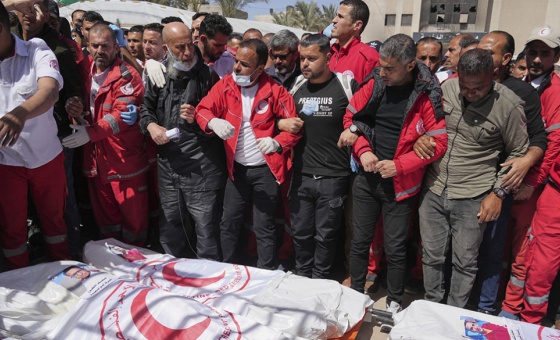This is the last article you can read this month
You can read more article this month
You can read more articles this month
Sorry your limit is up for this month
Reset on:
Please help support the Morning Star by subscribing here
“IF YOU are to do a proper history of Europe before the last five minutes, it is a history of white males … and to pretend anything else is to falsify,” opined David Starkey, the last time he had a TV series to plug.
It is, of course, Starkey and his ilk of historians who falsify: the truth is that it’s both easy and lucrative for them to stay within their comfort zone of white male history.
But there are serious consequences for the rest of us. Historians who don’t believe women, BME or working-class people ever really “did anything” won’t look for their stories, won’t make them “facts” of history.
Those whose stories they are might also fall for the line that their contribution can’t have been significant, so fail to pass them on or record them.
Historians like me, who want to tell the stories of working-class women in particular, often hear of mothers and grandmothers who did amazing things, but who barely mentioned them — partly from modesty and sheer busyness, but surely in part because of the belief that they are simply not history-makers.
I’m often asked: “But who’d want to hear my/my family’s story?” when in fact I’m champing at the bit to do just that.
If the so-called tales “from below” — in reality, from the majority of humanity — are lost, those of us whose inspirations they are could miss out on role models.
Neuroscience and psychology, as well as history, have all proved how crucial this is — if you can’t see it, it’s much harder to be it.
So while Ireland’s 1916 Easter Rising is finally being permitted into the historical mainstream outside of Ireland itself, we are still missing many women’s voices.
Hundreds of women took part: but until recently, we heard about few beyond Countess Constance Markievicz.
Although a woman (which couldn’t be helped) Markievicz, could be snuck in under the wire as a “great individual” and an aristocrat to boot, allowing her to be seen as an exception who didn’t threaten Starkey’s “rule.”
Irish families have always known women were an integral and equal part of events, and Irish historians have written about this: but there is so much more to know.
So when I found myself talking to a Dubliner in Sheffield a few weeks ago, after speaking at a Star supporters’ event, and she happened to casually mention that her grandmother was at the GPO in Easter 1916, I knew I’d got very lucky.
I’m privileged to be able to share with you the story of the Easter Rising through the eyes of the redoubtable Mrs Gertie Coley Murphy.
It’s a story all the more important for the human detail — how do you actually get to an uprising? How do you start it? What do you eat? — that “proper” historians often eschew, but anyone who’s been involved in so much as a demo or protest knows are absolutely key.
I’m grateful to Alma Egan and her family for their generosity in allowing me to share this remarkable story of an “ordinary” family risking their lives for a cause, brought to life vividly, with wit and astonishing sang-froid, in Gertie’s account.
Gertie Colley was born in Dublin in 1893, one of eight siblings. Her family were originally shopkeepers in Rathfarnham, south Dublin, but they sold up and moved to the inner city at some point, where Gertie worked in a butcher’s shop doing the books.
In November 1915, aged just 22, Gertie joined her local branch of the Cumann na mBan (League of the Women).
Formed in Dublin the year before, this was a republican women’s paramilitary organisation — effectively an army.
On the Thursday of Easter week 1916, Gertie received orders to mobilise her section for a route march on Easter Sunday.
On Sunday they duly assembled outside Liberty Hall in Dublin, only to be stood down to await further instructions in their homes.
This must have been a nail-biting wait, but Gertie is matter-of-fact, stating simply that the next day her brother Harry Colley was mobilised, and told his sister to gather her section and go to St Stephen’s Green, a city-centre park.
Gertie boarded a tram part of the way, falling in with two of her comrades, Amy Wisely and Tilly Simpson, en route.
As all activists know, the best laid plans often go awry — history may record a smooth sequence of events, but on the ground it’s often anything but.
So it proved for the three women. “When we got to the top of Grafton Street there was a cordon of Citizen Army men across it and they had orders not to allow anybody into the Green, so we decided to try Cumann na mBan HQ … but it was locked up, so we went back to O’Connell Street to try the GPO.
“But just then the windows were being broken [there] so we could not get in.”
The city was by this time in confusion. Gertie decided to take a number of volunteers back to her own house to regroup, and her mother made them a meal.
Gertie then marched with male volunteers, including her brother Harry, to another city centre open space, Fr Matthew Park, where “a Citizen Army girl came with an order from James Connolly for any Cumann na mBan to come to the GPO.
“We were brought to the back of the building on the ground floor, which was being fixed up as an emergency hospital … and keeping it fuelled.”
Other Cumann na mBans were out in the city commandeering food: “Meat, bread, cakes etc.”
Gertie continued feeding the troops all through the long day.
The GPO was under fire for the entire four days, and all inside it at continuous risk. Gertie recalled that this was underlined at one point by the sudden appearance of a priest in their midst.
Everyone was called to attention, and the priest “said he had power to give general absolution in danger of death, and considered everyone in this building was in danger of death: so he told us all to kneel down and say together the Act of Contrition, while he gave absolution.
“This was a most impressive scene; men of all walks of life, most of them unshaven and unwashed and yet so serious.
“I had a tray of mugs which I had to balance on the end of a table. Here I might mention we girls had our rosary beads hanging around our necks the whole time.”
By the second day Gertie had “lost all idea of time.” That night the women rested only in two-hour shifts, on mattresses on the floor.
On the Thursday, day four, Gertie volunteered for an extremely hazardous duty — taking food to “the men along the Henry Street windows” in another part of the GPO. These men were directly under fire and unable to leave their posts.
“So we loaded our trays and made our way through holes which had been blown in the walls. After pushing through a couple of rooms this way I saw a sight that made me feel sick…”
Gertie had seen what looked like the body of a little girl, her head blown completely off, but couldn’t allow herself to stop for a second: “We continued our rough climbing till we got to the building nearly opposite Moore Street … we were just managing to dish out tea and food when a heavy barrage of firing came through the windows.
“We had to stand in the jamb of the doors to avoid the bullets which were coming in. Lucky for me the walls were very thick. After some time we managed to finish serving food.
“One young man had got very ill and Captain Henderson [Frank Henderson, whom James Connolly had placed in command of the Henry Street men; later a prominent republican] asked us to get him back to the hospital.”
Carrying a sick man through ragged holes blown in a building under fire must have been arduous indeed: even Gertie allows that it was “some job.”
As the party came close to the room where she had seen the terrible sight of the dead child, Gertie felt awful trepidation — would she be able to bear passing it again?
As she was trying to keep her mind on the task at hand, she was suddenly suddenly struck by the realisation that the little “body” had apparently been free-standing, headless, which surely couldn’t have been possible.
With a surge of relief and amusement, Gertie realised what she had seen was a decapitated wax figure from the Dublin waxworks on Henry Street, a popular attraction at the time.
Through such pathos and bathos Gertie managed to get “our chap” to the hospital, and wrote a letter to his father back on Ballybough as he asked.
That night she witnessed the flames as the nearby Imperial Hotel burned down, and all the while “from scraps of information … I believed my brother Harry was in it.”
That night she had not a single break “as that part of the building was in danger.”
In the early hours of Friday morning, “we were upstairs in the kitchen … when we got orders to stop everything, get our coats and go to the ground floor.
“Pearse [Patrick Pearse, one of the 15 leaders later executed by firing squad], O’Rahilly [Michael O’Rahilly, a founder of the Irish Volunteers, who would die of his wounds in the street after being shot by the British; army officers would not allow him medical attention] and the other member of the HQ were there.
“Pearse addressed us and thanked and praised us for our help … Pearse handed me a large Red Cross flag, and then we received our orders. We were to proceed down Henry Street to Jervis Street hospital.”
Gertie was told to lead the group, with the flag.
“As the door of the GPO was about to be opened, Pearse called out: ‘Girl with the flag, march to the centre of the street’.”
“It was only a matter of seconds before the others joined us, but my legs felt like jelly.
“We turned into Henry Street to be confronted with our first [British Army] barricade. I scrambled up and held the flag on the top while the others got through at the side.
“We had I think three such barricades before we reached Jervis Street. The hospital could not take us in, so we had to turn back to Capel Street.
“Here the British soldiers were lined up across the street. An officer directed us to continue … each side street was barricaded and manned by soldiers and so we continued until we came to the junction of Summer Hill and North Circular Road.”
Here the women were stopped and questioned by British Army officers. They could not have known whether they would be arrested or even shot — but, probably thanks to Pearse’s Red Cross flag, were eventually allowed home.
Gertie later discovered her fears for her brother Harry were well-founded, though he had not in fact been caught up in the Imperial Hotel fire.
Harry had in fact been shot by the British soldiers on O’Connell Street, presumed dead and taken to a morgue.
There the workers discovered signs of life. He was given no medical help but taken back to O’Connell Street where his unconscious body was abandoned, propped against a barricade.
Incredibly he survived, and in 1944 became a Teachta Dala, a member of the Irish Dail.
From 1977 to 1981, Harry’s son, George Colley, a Fianna Fail politician, served as Ireland’s Tanaiste (deputy prime minister).
Gertie went on to marry Jack Murphy and have eight children, living in the Drumcondra area, close to the original family home. She died in 1983.
Her granddaughter Alma says today that Gertie talked so little of her part in events, her daughter (Alma’s mother) only discovered from a brief reference in Liz Gilles’s book Women of The Irish Revolution that Gertie was active after 1916 in her local anti-treaty group (opposing the Anglo-Irish Treaty which officially ended the war of independence in 1921), acting both as treasurer and as a courier for Captain Frank Henderson.
Only on the anniversary of the Rising in 1966 could Gertie be persuaded to set down the bare bones of her story, which have formed the basis of this article.
“Like a lot of women she never discussed her time in 1916 or the war of independence,” says Alma.
“However, she was a good woman, and did everything to help her kids and grandkids after her husband died.
“I would speculate that she would be proud of the nation Ireland became: that it became a country that could stand on its own two feet.
“I doubt she ever thought that 100 years later hundreds and thousands of people would be arriving in Ireland to see where it all happened.
“At the end of the day, she was a young woman who did what she had to do for the country she loved and I’m so very, very proud of her.”
- Louise Raw is the author of Striking a Light and organises the annual Matchwomen’s Festival, for which the Star is media sponsor. This year’s fest is on July 2: tickets via Eventbrite (mstar.link/matchfest-2016) or www.facebook.com/Matchwomen.







